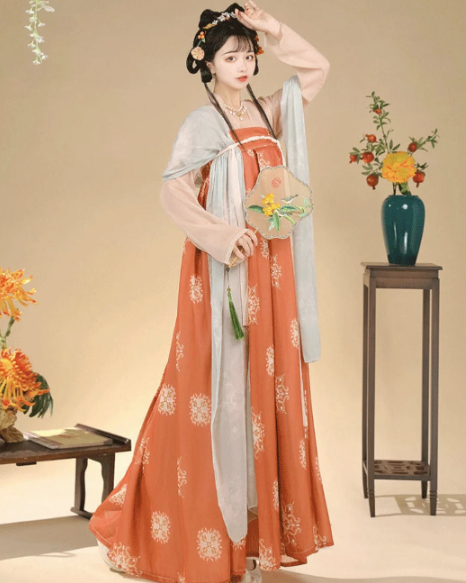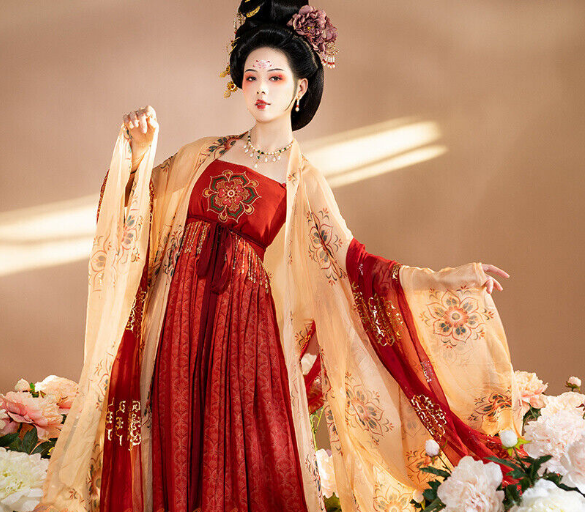The Tang Dynasty Hanfu was known for its diverse styles, luxurious fabrics, vibrant colors, and elaborate accessories.
Historical Context of Tang Dynasty Hanfu
The Tang Dynasty, a period marked by prosperity and artistic innovation, reigned from 618 to 907 AD. This era, often celebrated for its cultural richness, witnessed the flourishing of arts, literature, and a cosmopolitan lifestyle. As a pivotal time in Chinese history, the Tang Dynasty’s open-mindedness and its embrace of diverse cultural elements profoundly shaped Hanfu, the traditional clothing of the Han Chinese.
The Tang Dynasty
The Tang Dynasty stood out as a golden age in Chinese history. Its capital, Chang’an (present-day Xi’an), emerged as one of the largest and most cosmopolitan cities of the time. The dynasty’s economy thrived due to extensive trade along the Silk Road, enhancing its wealth and influence. This period saw the reign of Emperor Taizong and Empress Wu Zetian, China’s only female emperor, who significantly impacted the dynasty’s political and cultural landscape. The Tang era, renowned for its poetry and painting, also advanced in science and technology, with inventions like woodblock printing and gunpowder.

Cultural and Social Influences on Hanfu
The cultural and social milieu of the Tang Dynasty greatly influenced the evolution of Hanfu. Influences came from as far as Persia and Byzantium, transforming Hanfu into a symbol of cultural synthesis. The clothing styles were indicative of social status and profession, enabling a visual representation of the societal hierarchy. Women’s fashion, particularly, saw revolutionary changes. They started wearing high-waisted dresses and blouses with wide sleeves, a stark contrast to the confining clothes of previous eras. The men’s Hanfu, while less varied than women’s, evolved in its color schemes and fabric choices, reflecting the wearer’s rank and occupation.
This era of openness led to the incorporation of luxurious materials like silk, satin, and brocade, making Hanfu not just a clothing choice but a display of artistry and status. The popularity of vibrant colors and intricate patterns in Hanfu mirrored the Tang Dynasty’s overall aesthetic preferences. These garments often featured motifs inspired by nature, poetry, and Buddhist symbolism, showcasing the era’s artistic sensibilities.
In sum, the Tang Dynasty’s Hanfu was not merely clothing; it was a canvas reflecting the era’s cultural diversity, economic prosperity, and artistic achievements. The style, fabric, and colors of Hanfu during this period vividly tell the story of a society that valued aesthetic beauty, social distinction, and cultural exchange.
Key Features of Tang Dynasty Hanfu
The Tang Dynasty’s Hanfu stands out in history for its distinctive features that reflect the era’s artistic and cultural zenith. This traditional attire, renowned for its elegance and diversity, showcases a blend of aesthetics, materials, and symbolic meanings, deeply rooted in the Tang Dynasty’s rich cultural milieu.
Silhouettes and Styles
Hanfu during the Tang Dynasty showcased a variety of silhouettes and styles, each signifying different social statuses and fashion trends. For women, the most iconic style was the “Ruqun,” a combination of a blouse and a wrap-around skirt. The blouse typically had wide, flowing sleeves and a low, cross-collar neckline, while the skirt often sat high on the waist, creating an elongated, graceful silhouette. Men’s Hanfu usually consisted of a “Shenyi,” a full-body garment that integrated a tunic and a skirt or trousers. This garment symbolized dignity and grace, especially when adorned with intricate patterns and fine stitching. Additionally, “Pao,” a type of robe worn by both genders, varied in length and design, indicating the wearer’s social rank and occupation.
Fabric and Materials
Luxury fabrics were a hallmark of Tang Dynasty Hanfu. Silk, highly prized for its texture and sheen, was the predominant material, often enhanced with gold and silver threads to add opulence. The use of brocade, a richly decorative shuttle-woven fabric, was prevalent, especially in garments for the upper class and royalty. Cotton and linen were also in use, mainly for everyday wear. The quality and texture of these materials not only provided comfort but also displayed the exquisite craftsmanship of Tang artisans.
Colors and Patterns
The color palette of Tang Dynasty Hanfu was vibrant and varied, reflecting the era’s cosmopolitan nature. Red, gold, green, and blue were popular choices, symbolizing prosperity, nobility, vitality, and tranquility, respectively. Patterns often included floral motifs, cloud designs, and geometric shapes, many of which bore symbolic meanings. For instance, the lotus pattern symbolized purity and enlightenment, resonating with the era’s Buddhist influences. The use of contrasting colors and intricate designs in Hanfu highlighted the Tang Dynasty’s aesthetic preferences and cultural richness.
Accessories and Ornaments
Accessories and ornaments played a crucial role in complementing Tang Dynasty Hanfu. Women adorned themselves with hairpins made of gold, silver, jade, or pearls, often intricately designed with floral or animal motifs. These hairpins were not just decorative but also indicated the wearer’s social status. Belts, often made of silk or leather and embellished with precious stones, were essential for both men and women, serving both functional and decorative purposes. Jewelry such as necklaces, bracelets, and earrings, often made of gold, silver, or semi-precious stones, added an extra layer of elegance to the Hanfu.
Tang Dynasty Hanfu was a vivid expression of the period’s cultural confidence and artistic creativity. Its features – from the elegant silhouettes and luxurious fabrics to the vibrant colors and intricate accessories – paint a picture of a dynamic and prosperous era, deeply invested in aesthetic refinement and cultural expression.
Gender Variations in Tang Dynasty Hanfu
In the Tang Dynasty, Hanfu garments distinctly varied between men and women, reflecting the era’s social customs, aesthetic preferences, and cultural values. These variations were not just about style and form; they also communicated the societal roles and statuses of the wearers.
Women Hanfu Garments
Women’s Hanfu in the Tang Dynasty was characterized by its elegance and diversity, reflecting the era’s liberal views on female fashion. The most iconic garment was the “Ruqun,” comprising a blouse and a skirt. The blouse, known for its cross-collar and wide sleeves, allowed for ease of movement and comfort. The skirt often had a high waist, creating a long, flowing silhouette that epitomized grace and femininity. Another popular style was the “Beizi,” a long tunic that reached the knees, worn over the Ruqun, providing additional layers and complexity to the outfit.
Fabrics ranged from lightweight silks in summer to heavier brocades in winter, often adorned with intricate embroidery that showcased the Tang Dynasty’s advanced textile techniques. Women’s Hanfu colors were vibrant and varied, with a preference for bright and pastel shades, each symbolizing different virtues and qualities. Accessories played a significant role in women’s attire, with hairpins, jewelry, and ornate belts adding a touch of luxury and status to their outfits.

Men Hanfu Garments
Men’s Hanfu during the Tang Dynasty, while less varied than women’s, was equally significant in demonstrating social status and personal style. The primary garment was the “Shenyi,” a full-body robe that combined a tunic with a skirt or pants. This garment was characterized by its simplicity, straight lines, and an emphasis on practicality and dignity. The “Shenyi” often featured a cross-collar, similar to women’s blouses, and was held together with a sash or belt.
The fabrics used for men’s Hanfu were similar to women’s, with silk being the most prevalent, but the colors were typically more subdued, reflecting the Confucian ideals of modesty and restraint. Patterns were less elaborate, often consisting of simple geometric shapes or subtle floral designs. Men’s accessories were fewer but included hats, belts, and sometimes boots, each carefully chosen to complement their attire and social standing.
In summary, the gender variations in Tang Dynasty Hanfu reveal a society that valued aesthetic expression and social distinction. Women’s garments were elaborate and colorful, reflecting a period of relative freedom and creativity in female fashion, while men’s clothing was more subdued and structured, mirroring their roles and responsibilities within Tang society. Both, however, stood as testament to the era’s sophisticated textile arts and its rich cultural tapestry.
Evolution of Hanfu in the Tang Dynasty
The Tang Dynasty, a beacon of cultural and artistic innovation, witnessed significant evolution in the style and design of Hanfu, the traditional Chinese attire. This evolution not only reflects the changing tastes and fashions of the era but also the influence of foreign cultures and trade.
Early Tang vs. Late Tang Styles
In the early Tang period, Hanfu was relatively simple and modest, mirroring the era’s emphasis on Confucian values of restraint and simplicity. Women’s attire typically consisted of narrow-sleeved blouses and long skirts with a high waist, creating a slender and elongated silhouette. Men’s clothing was similarly understated, characterized by narrow sleeves and straight-cut robes.
As the dynasty progressed into the late Tang period, Hanfu became more elaborate and diverse. Women’s fashion, in particular, saw a dramatic shift. The introduction of wide sleeves, low necklines, and the use of multiple layers of clothing became prevalent. Skirts became fuller, and the use of sheer fabrics increased, adding a sense of luxury and sophistication to women’s attire. Men’s Hanfu also evolved, with broader sleeves and more elaborate designs, reflecting the era’s growing opulence.
This transformation in style was not just a fashion statement; it indicated broader social and cultural shifts within Tang society. The late Tang period was marked by increased wealth, cosmopolitanism, and a move away from the strictures of early Tang Confucianism, which was reflected in the more flamboyant and diverse styles of Hanfu.

Influence of Foreign Cultures
The Tang Dynasty was a period of extensive cultural exchange, largely due to the Silk Road, which connected China with the Middle East, Europe, and other parts of Asia. This interaction with various cultures significantly influenced Hanfu styles.
Foreign fabrics and designs started making their way into Chinese fashion. For example, the use of Persian patterns and Indian cotton in Hanfu was not uncommon. These influences were especially evident in the use of vibrant colors and intricate patterns that became popular in Tang attire.
The influence of Buddhist culture, which was gaining prominence in China during this period, can be seen in the clothing styles. The use of flowing robes and more relaxed silhouettes in Hanfu bore a resemblance to traditional Buddhist attire. This cultural intermingling led to a unique fusion of styles, which became a hallmark of Tang fashion.
The evolution of Hanfu during the Tang Dynasty reflects a period of immense cultural richness and openness. From the modest and simple styles of the early Tang to the luxurious and diverse fashions of the late Tang, these changes mirror the social, economic, and cultural transformations of the era. Moreover, the incorporation of foreign elements into Hanfu underscores the Tang Dynasty’s role as a cosmopolitan and influential cultural center in ancient times.







